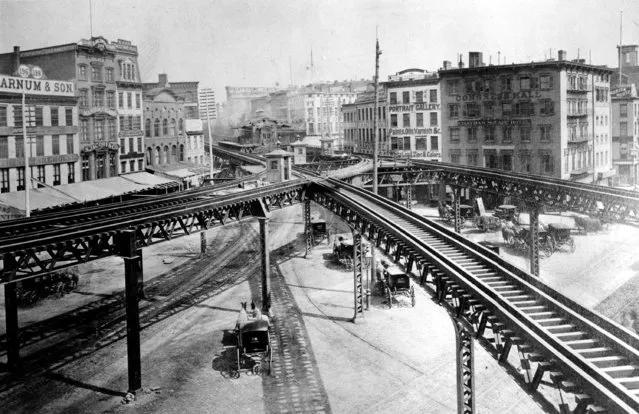
This is an 1878 view of the Third Avenue Line El train tracks, looking north up the east side of the Bowery, at Chatham Square in lower Manhattan, New York. (Photo by AP Photo)
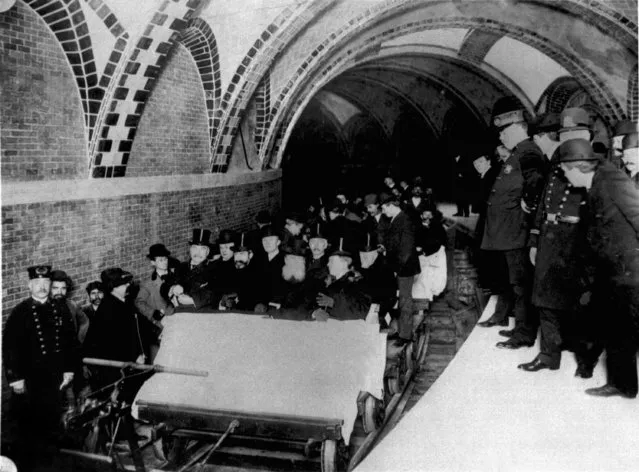
This group of financiers and city officials get a tour of New York City's first subway in January 1904 while the city's policemen stood by on the platform at City Hall Station. Seated toward the front of the ceremonial flat car are Alexander Orr, August Belmont, John B. McDonald, and Mayor George B. McClellen. (Photo by AP Photo/NYC Transit Authority)
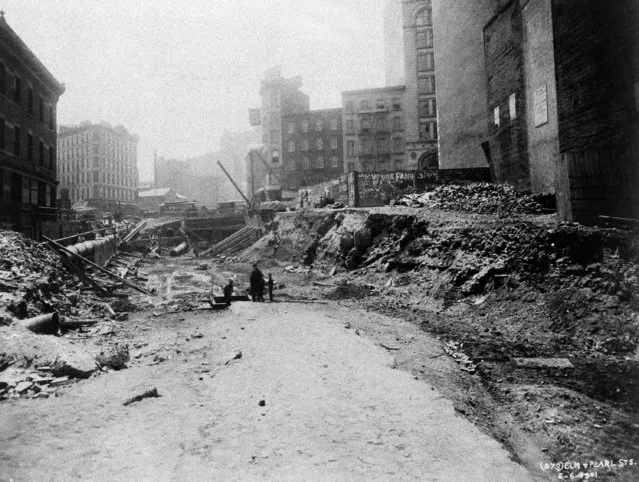
This is excavation at Lafayette Street, then known as Elm Street, near Pearl Street, for New York's subway line, seen May 6, 1901. (Photo by AP Photo)
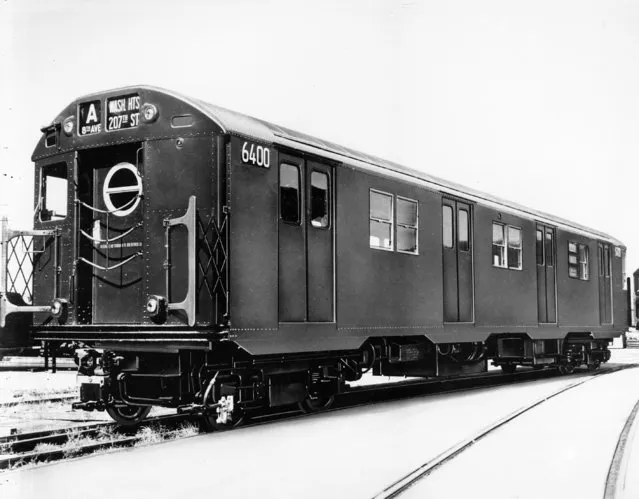
This is an undated photo of a New York City subway car, the “A” train. (Photo by AP Photo)
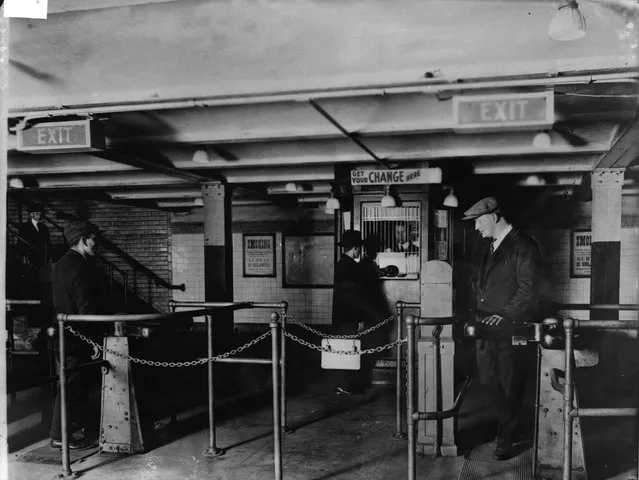
A man gets change in nickels from a change booth operator so he can pass through the new nickel-operated turnstiles which have replaced the ticket and ticket-chopper (a man who manually cut tickets at the gate) system in the New York City subway, early 1920s. The move allowed subway companies to reduce operating costs by drastically reducing personnel. (Photo by FPG/Getty Images)
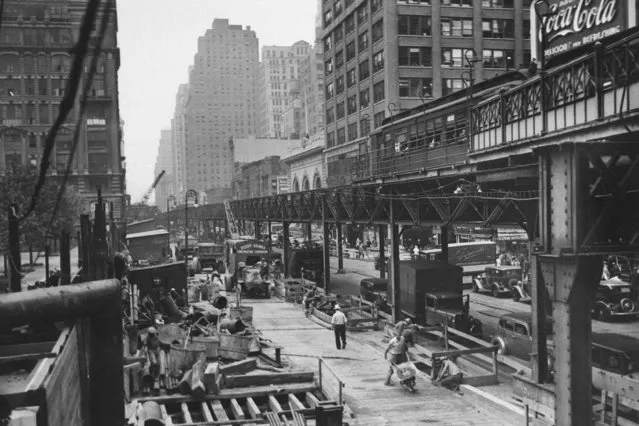
Work begins for an underground replacement for the Sixth Avenue “El” (elevated train), shown looking north from 42nd Street, July 28, 1936. The El is to be demolished in 1939. (Photo by AP Photo/HS)
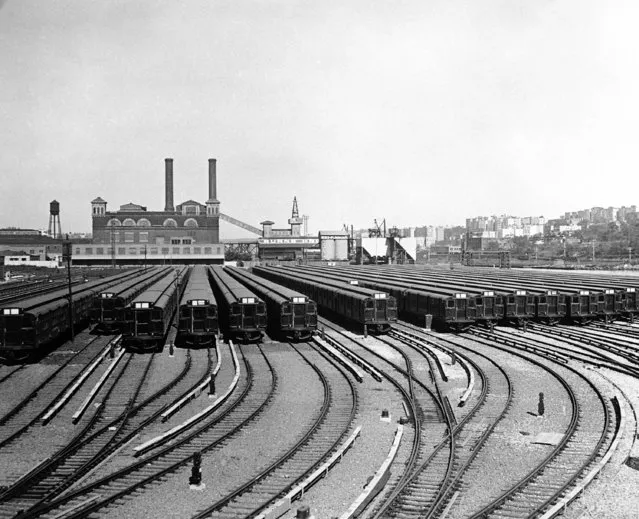
Steel cars for the new 8th Avenue subway in New York, in May 1937. (Photo by AP Photo)
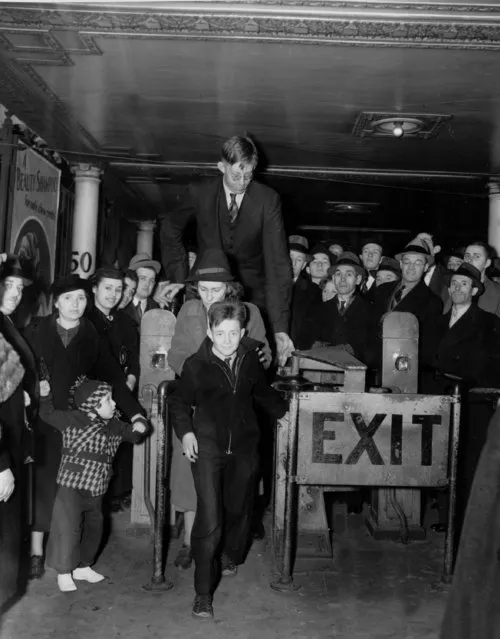
Robert Wadlow, 18, of Alton, Ill., enters a turnstile at a New York City subway station, April 7, 1937. (Photo by AP Photo)

This is an interior view of the new 8th Avenue subway car in New York City, May 1937. (Photo by AP Photo)
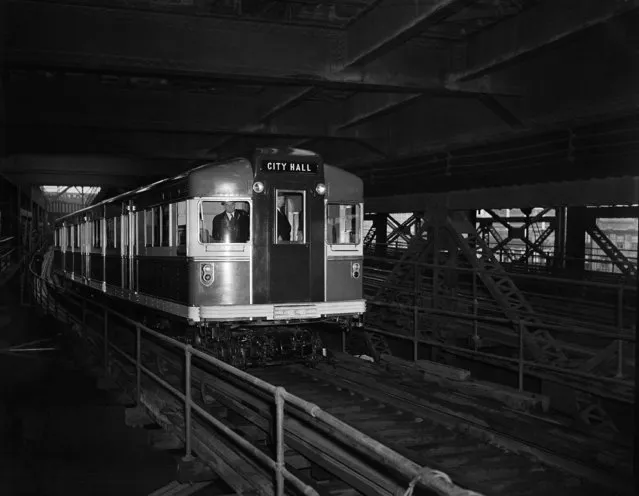
The new streamlined red, white and blue Rapid Transit car which made its “maiden voyage” along the BMT lines in New York, March 28, 1939. It weighs 76,000 pounds, about half the weight of the conventional cars, and is equipped with special sound-deadening and shock-cushioning devices. (Photo by AP Photo)

Air conditioned and equipped with upholstered green mohair cushions, a new streamlined luxury car of the BMT lines made its inaugural run in New York, March 28, 1939. This group tried out the comforts of the new car which will be placed in operation March 30. Sound-deadening and shock-absorbing devices are part of the new equipment. (Photo by AP Photo)
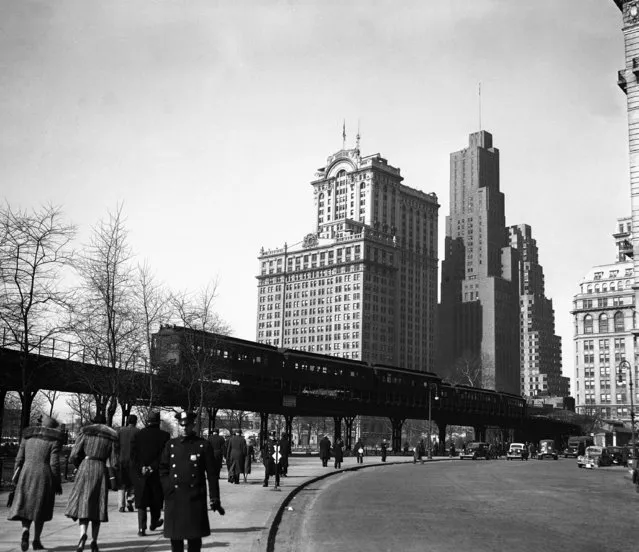
The Ninth Avenue “El” or elevated, is shown looking north along State Street in New York, February 22, 1940. The transit commission has authorized the condemnation of the structure. (Photo by AP Photo)
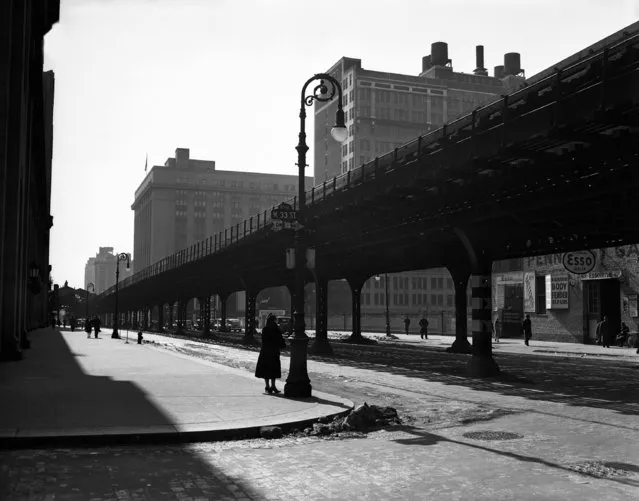
The Ninth Avenue “El”, or elevated, tracks are seen looking south at 33rd Street in New York, February 22, 1940. The transit commission authorized condemnation of the structure. (Photo by AP Photo)

This view shows the 42nd Street subway entrance and store fronts in New York City on April 2, 1940. (Photo by AP Photo)
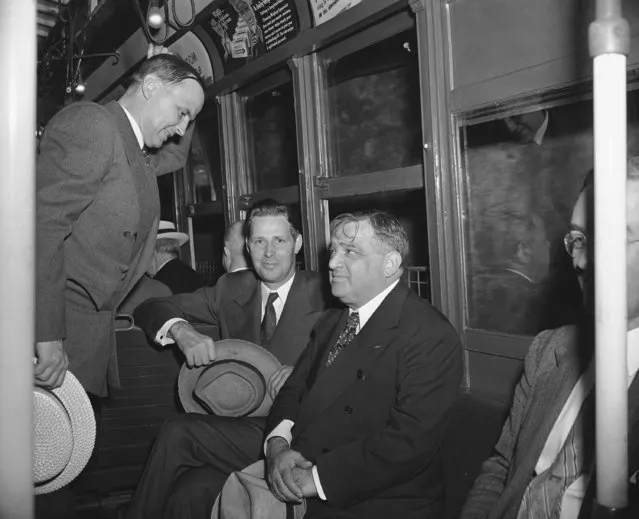
Mayor John F. Carr of Medford, Mass., Mayor Maurice J. Tobin of Boston, and Mayor Fiorello La Guardia of New York, left to right, take a subway to go from City Hall to their hotel for lunch in New York, August 5, 1942, after conferring with mayors of Atlantic Coast cities on gasoline and fuel problems for the northeast. (Photo by AP Photo/Abe Fox)
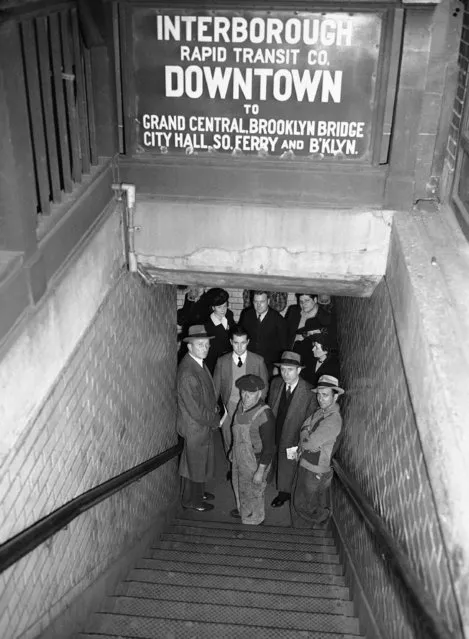
New Yorkers, caught in a surprise air raid warning alert seek shelter in stores and subways. A crowd waits for the “all clear” in a subway station at Lexington Avenue and 51st street, October 22, 1942. (Photo by AP Photo)
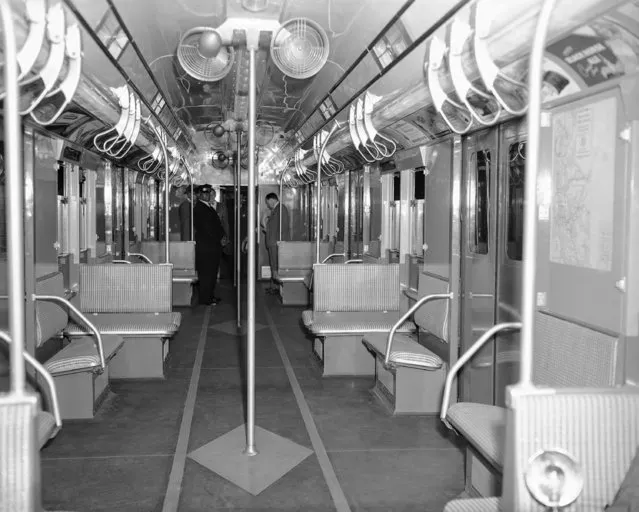
Interior view of the subway car of the future as it was displayed at the Chambers Street Station of the Independent Division in New York on July 9, 1947. The new car has 56 seats, 14 adjustable, exhaust ventilators, eight 10-inch fans, is painted blue and grey and has an off-white ceiling. (Photo by Anthony Camerano/AP Photo)
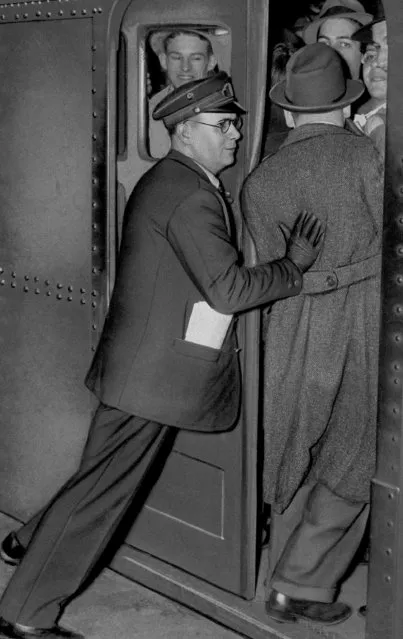
New York City subway worker squeezes one more onto a train car, May 5, 1943. (Photo by AP Photo)
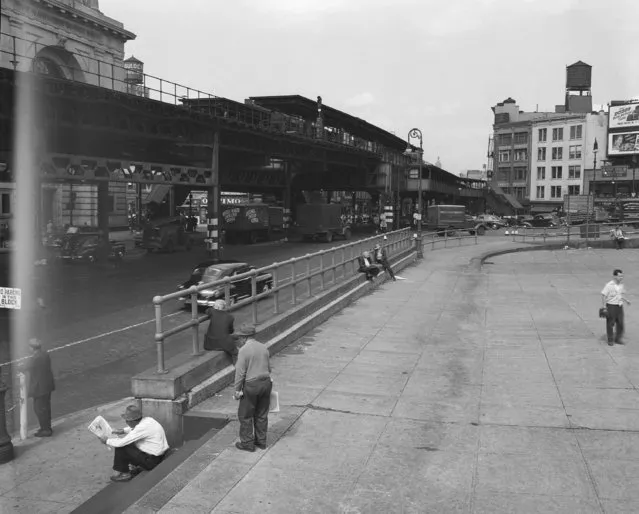
The photo shows the Bowery where it intersects with Canal Street in New York, 1947. The Third Avenue El, or, Elevated, train is on the left. (Photo by Ed Ford/AP Photo)
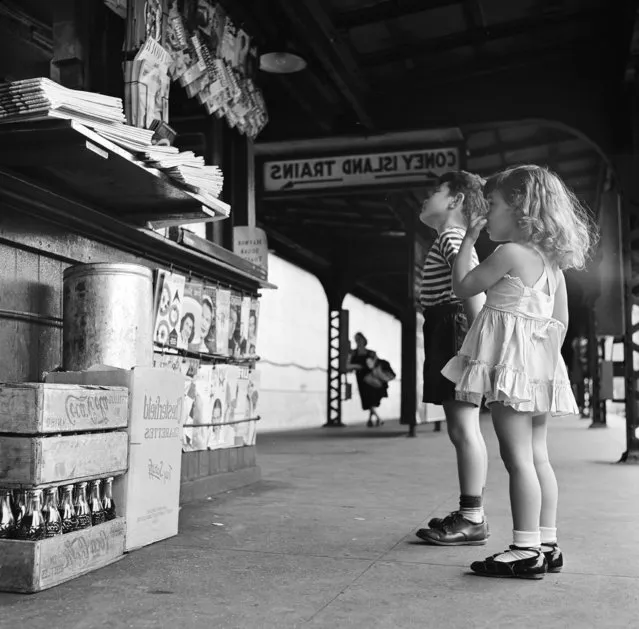
A brother and his sister look up at a newsstand, located on the platform of the New York city subway, as they wait for the train to Coney Island, New York, 1948. (Photo by Getty Images)
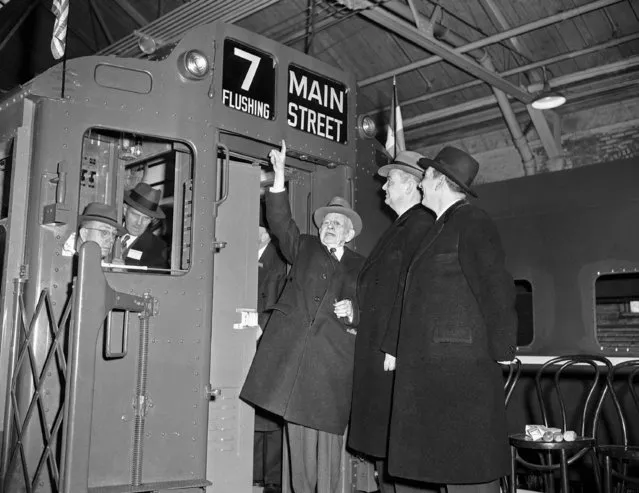
Vincent R. Impellitteri, right, acting mayor of New York City, and Brooklyn Borough President John Cashmore (second from right), inspect the first completed subway car of an order for 750, at the American Car and Foundry Co., Berwick, Penn., February 20, 1948. C.J. Hardy, Sr., company chairman, points out a feature of the new cars. Men inside subway cab are unidentified. (Photo by AP Photo/HG)
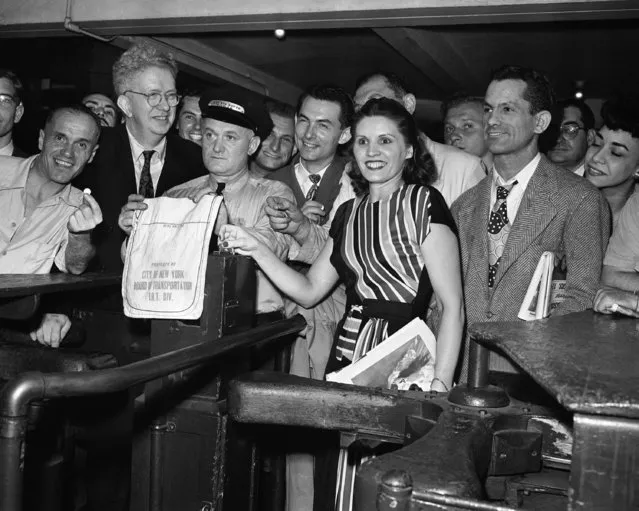
Carmen Gherdol of Long Island City, N.Y. drops the last nickel permitted to be dropped in one of the BMT-IRT subway turnstiles at Times Square, New York, June 30, 1948 when the fare was raised to ten cents for a subway ride in New York City. Assistant supervisor Bartholomew Barry, left, prepares to pull a canvas cover over the slot, until it is changed over to receive the smaller coin. Others are unidentified. (Photo by Matty Zimmerman/AP Photo)

Changing from one subway line to another, passengers at the IND line's Broadway-Nassau St. station crowd through aisles to get free transfers from transportation employees under the city's new ten-cent fare, July 1, 1948. Transfer is required here where three lines meet, to prevent passengers from coming in from street and obtaining free rides. Confusion resulted when some passengers neglected to obtain their transfers. Guards permitted them to go back for transfers but many, rather than waste time, paid another dime. (Photo by Anthony Camerano/AP Photo)
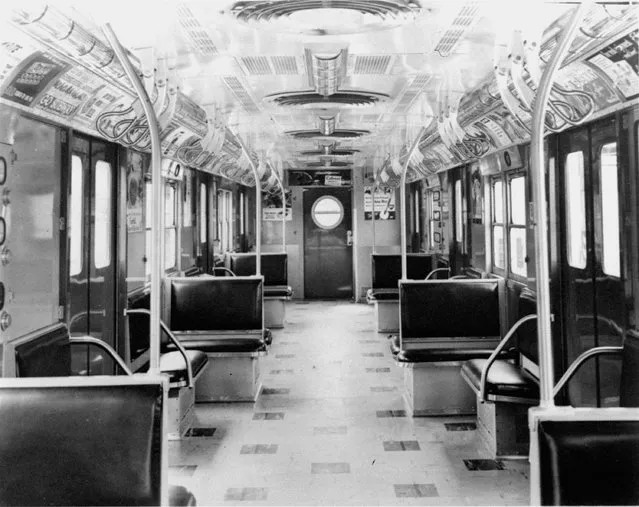
Patterned asbestos tile flooring, increased and improved fluorescent lighting, illuminated route and destination signs, double roofs, and electronically controlled heat and ventilation, improved brakes and door controls, and foam and vinyl seats are among major changes designed for passenger comfort and greater operational and maintenance efficiency in New York City subway cars on October 26, 1954. (Photo by AP Photo)
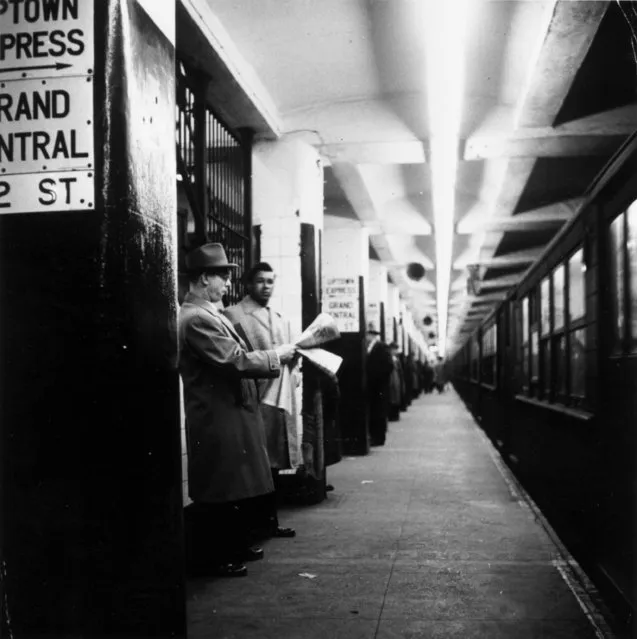
A subway station in New York in 1955. (Photo by Three Lions/Getty Images)
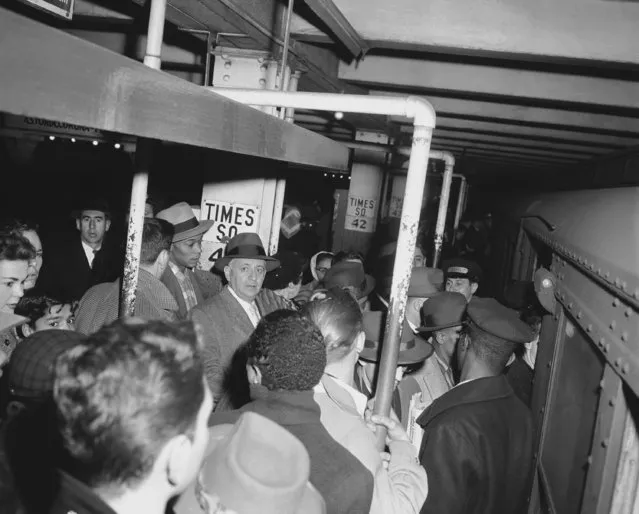
Crowd at Times Square station subway in New York City on March 6, 1956. (Photo by AP Photo/HVN)
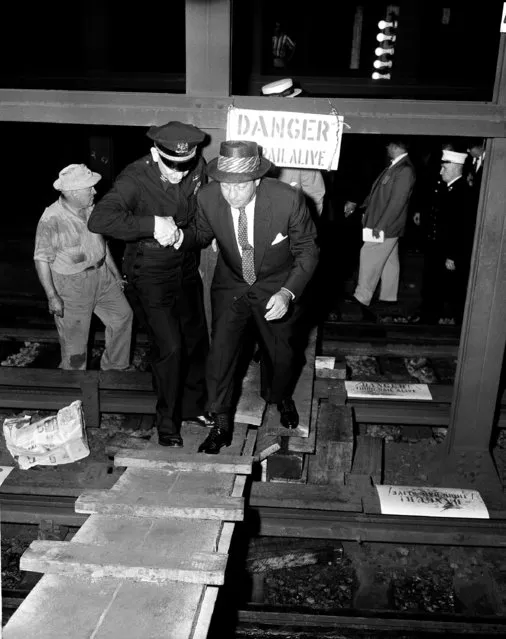
Mayor Robert Wagner of New York moves across damaged tracks in the Astor Place Station of the IRT's Lexington Avenue line with assistance of inspector Edward Stanley, left, during a brief tour of the station, July 1, 1956. Mayor Wagner announced after inspecting the tracks that service would be restored on the East Side line on July 20. Service was disrupted on July 14 when water poured on the nearby Wanamaker store fire flooded the station and caused the tracks to sink. (Photo by John Lent/AP Photo)
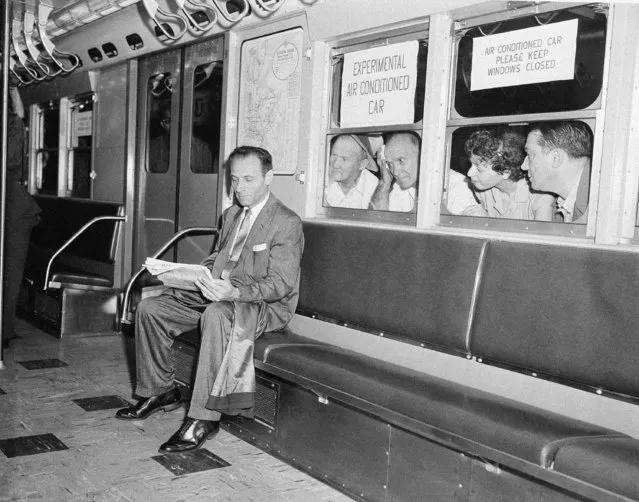
While other subway passengers perspire in the warm and humid underground station, Paul Forman appears cool and comfortable in the experimental air conditioned train which made its first run in New York City, July 9, 1956. The test run, which included six air conditioned cars and two old cars, was made on the East Side IRT line. The new cars provide soft music, modern design, air cooling units, deodorizers and filters to reduce germs. When the train left Grand Central Station the temperature was 89-degrees in the old cars while the new cars registered 76.5 degrees. (Photo by Harry Harris/AP Photo)
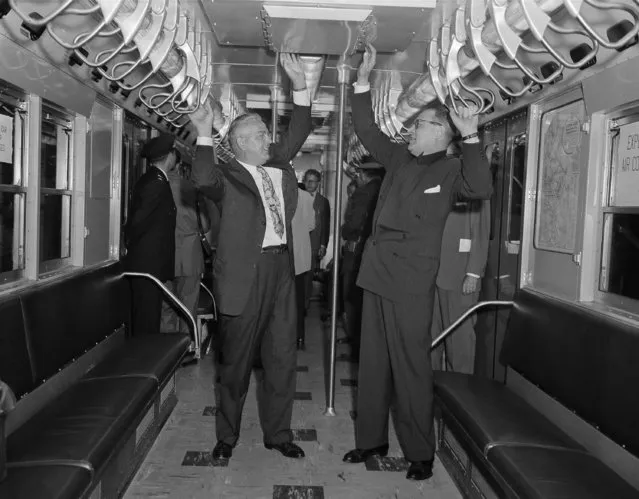
Subway commissioner Joseph E. O'Grady, left, and Transit Authority Chairman Charles L. Patterson try straphanging and feeling the cool air coming from the ceiling ducts in an air conditioned subway car, July 9, 1956. (Photo by Harry Harris/AP Photo)
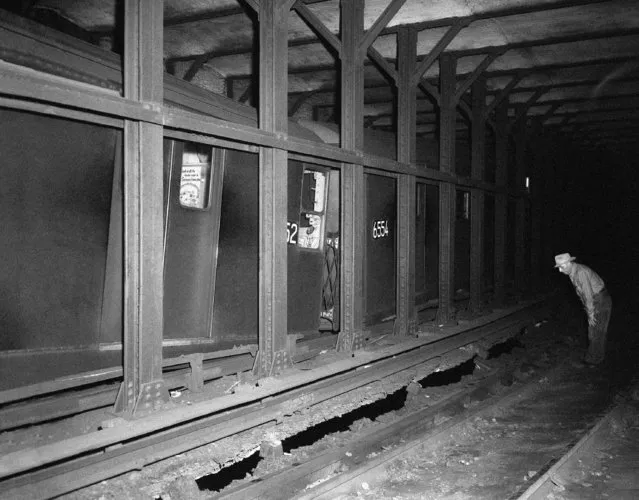
Two cars of the Lexington Avenue subway train were caught on collapsing tracks in the Astor Place station, July 15, 1956. The tracks collapsed as a result of seepage from the more than 100,000 gallons of water poured on the fire in the old Wanamaker department store in New York. The stalled cars were the last half of a four-car train moving through the station when the tracks collapsed. Passengers in the cars escaped injury and made their way into the first two cars which continued out of the station. (Photo by AP Photo)
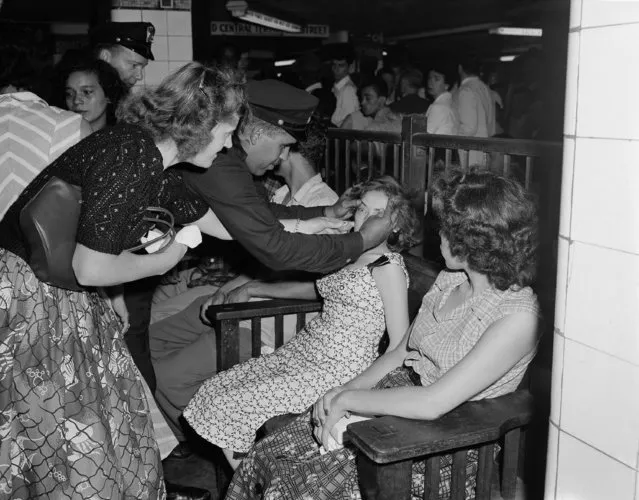
Juana Otero, a victim of heat exhaustion in the abnormally packed Grand Central subway station in New York, gets assistance from transit policeman Arthur Dixon as other victims rest in a corner of the station, July 16, 1956. Numerous other rush hour travelers required aid as a surging mass of humanity sought shuttle transport to the West Side subway system after a busy section of the East Side tube was put out of commission as a result of the weekend fire in the Old Wanamaker department store. (Photo by Jacob Harris/AP Photo)
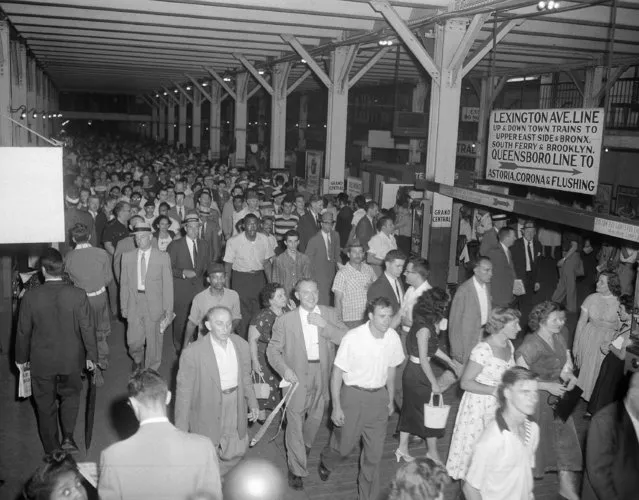
Crowds of homebound New Yorkers move slowly toward the Grand Central station of the IRT's Lexington Avenue line after leaving the crosstown shuttle during the peak of the rush hour, July 16, 1956. Flooding from water poured on the Wanamaker department store building fire has disrupted Lower East Side subway service and forced straphangers to use West Side lines. At Grand Central, where riders switched from west to east side lines, crowds were described as twice as heavy as normal. (Photo by Tom Fitzsimmons/AP Photo)
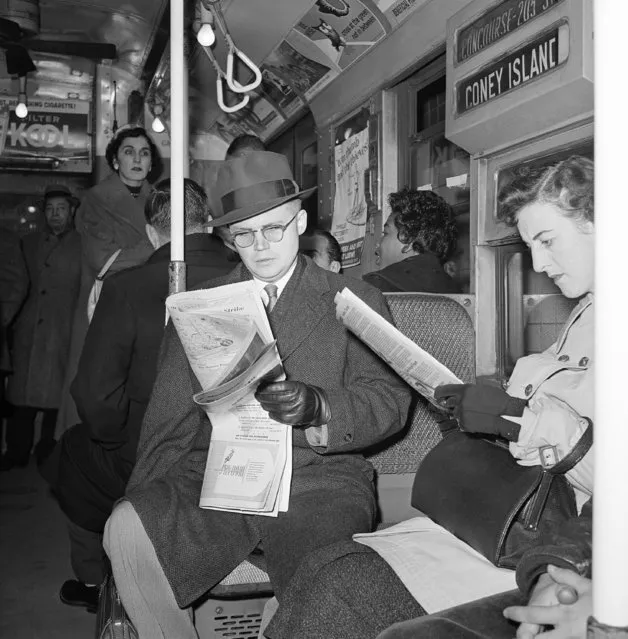
Subway riders in news-hungry New York returned to their favorite reading matter after end of newspaper strike, December 29, 1958. (Photo by Anthony Camerano/AP Photo)
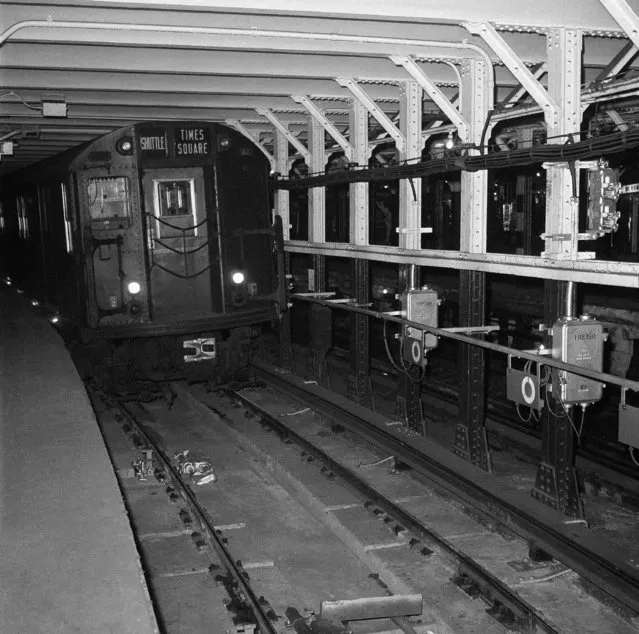
This is a head-on view of the automated subway shuttle train, scheduled to operate between Grand Central Station on New York's East Side and Times Square on the West Side of Manhattan, December 13, 1961. The train is slowing to a stop at Times Square station during one of a series of test runs Circles on posts at right are proximity deductors which monitor speed of the approaching train. The crewless train, operated entirely by electronic controls, is scheduled to begin operation in a few days and is the cause of a strike threat by the Transport Workers Union. (Photo by Anthony Camerano/AP Photo)
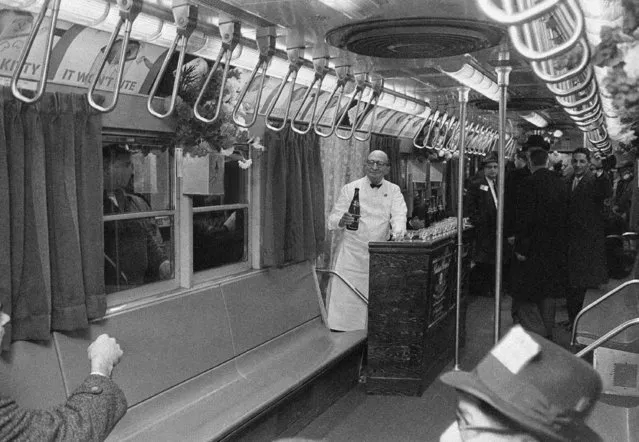
Joseph E. O'Grady, right, member of New York City's Transit Authority, stands at bar installed temporarily in the Authority's “dream car” in New York, January 17, 1962. The car, which had fresh flowers, carpeting, draperies and pastel lighting, made a special trip as part of a nine-car train on the city’s subway lines from Times Square to South Ferry and back. It was to help publicize a clean subways campaign to the Young Men's Board of Trade New York City Junior Chamber of Commerce. (Photo by John Rooney/AP Photo)
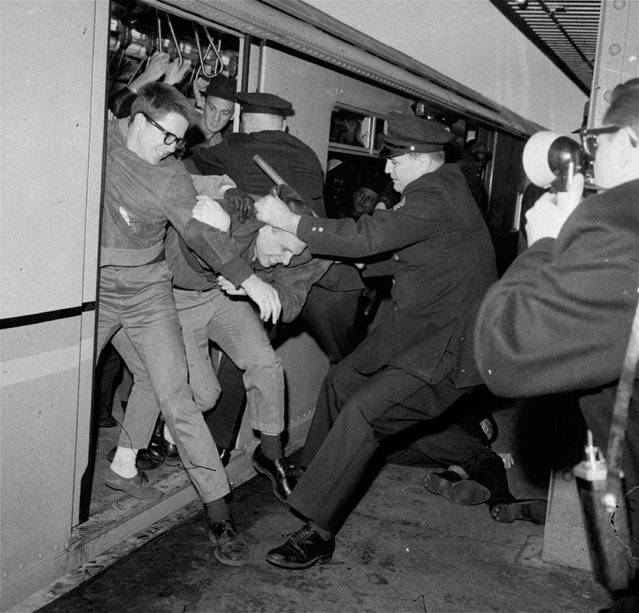
New York City policemen tangled with demonstrators at a subway station on the opening day of the New York World's Fair, April 22, 1964. Youths attempted to stall the train, which was headed from the city to the fairgrounds, as a form of protest on behalf of civil rights for blacks. (Photo by Charles Gorry/AP Photo)
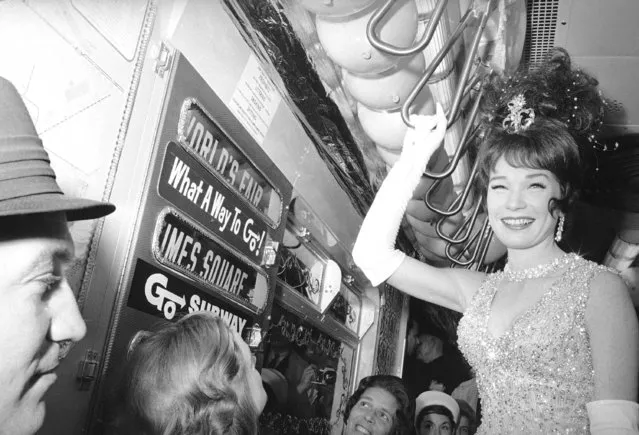
Actress Shirley MacLaine rides the New York subway on her way to the World's Fair for the premiere of her film “What A Way to Go”, May 13, 1964. (Photo by Marty Zimmerman/AP Photo)
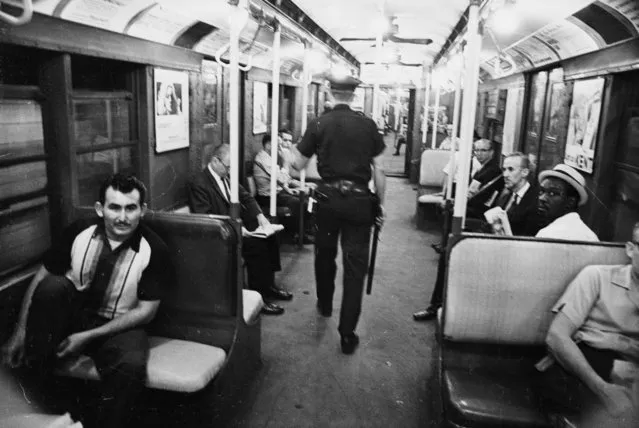
An American policeman on patrol in the New York subway, August 11, 1965. (Photo by Harry Benson/Express/Getty Images)
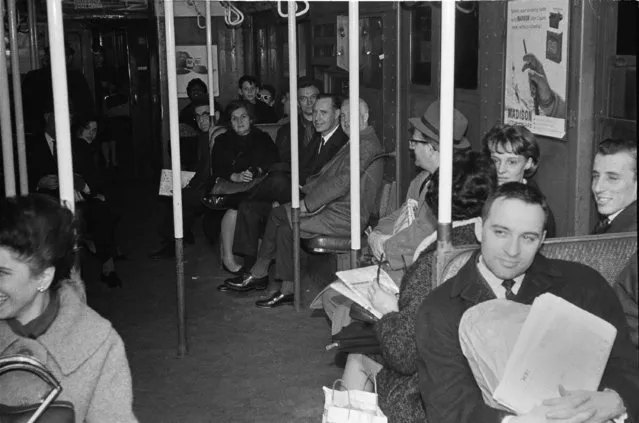
Passengers sit patiently in near-darkness in a stalled subway car at West 4th Street in the Manhattan section of New York, November 9, 1965, during the massive power failure that darkened a vast portion of the northeast including New York State, most of New England, parts of New Jersey and Pennsylvania, and Ontario, Canada. (Photo by Jerry Mosey/AP Photo)
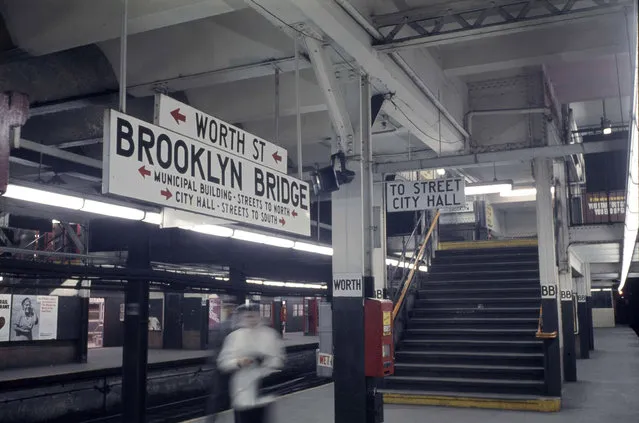
This is the platform at the Worth Street subway station in lower Manhattan, shown during a non-rush hour time, January 7, 1966. (Photo by AP Photo)
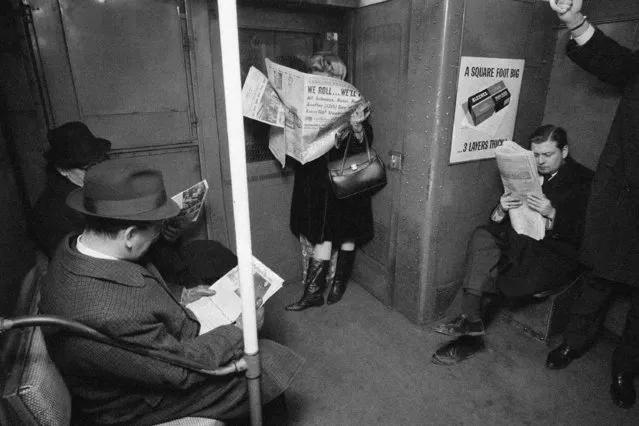
New Yorkers who used to complain about the crush of riding the subway during the rush hours have had 12 subway-less days to change their minds, there were no such complaints heard from the passengers of this crowded train, January 13, 1966. Everybody was happy the crippling transit strike was over. (Photo by AP Photo)

New York City subway train packed with commuters during rush hour in 1966. (Photo by AP Photo)
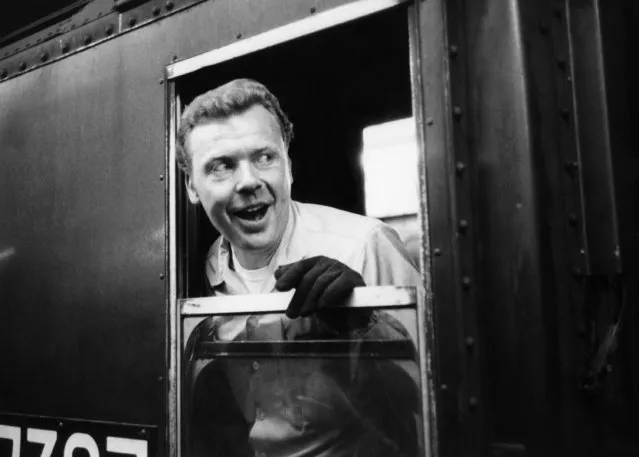
An unidentified conductor for an IRT subway train is shown on the job in New York, July 10, 1970. (Photo by AP Photo)
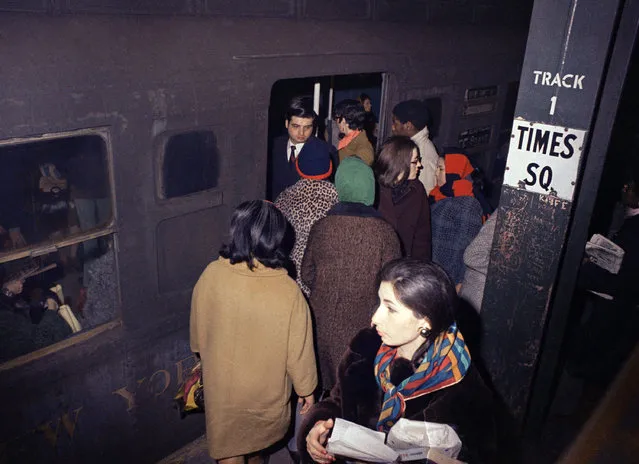
Subway crowds at Times Square Station in New York March 4, 1970. (Photo by Anthony Camerano/AP Photo)
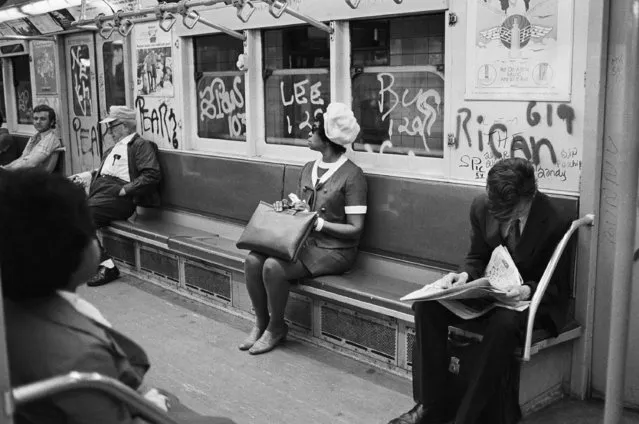
Graffiti on New York City subways shown on July 26, 1972. (Photo by Jim Wells/AP Photo)
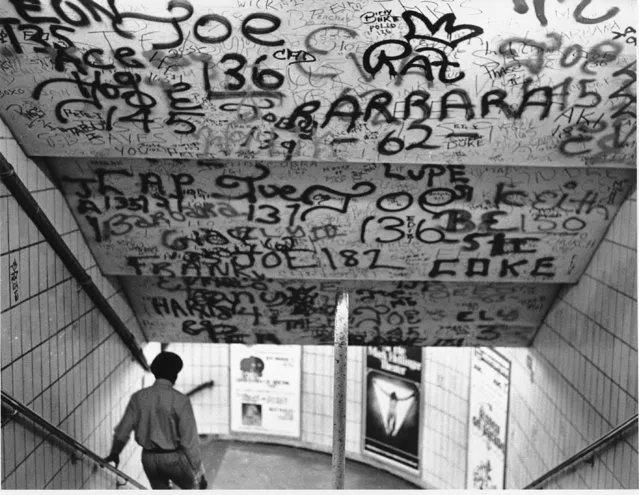
Graffiti sprayed on the subway of New York on July 27, 1972. (Photo by AP Photo)
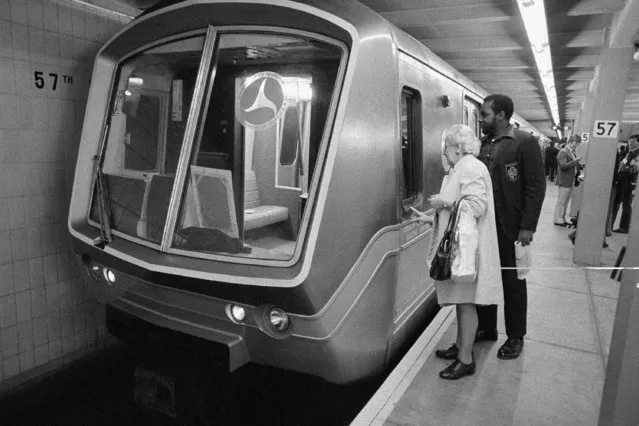
Two curious subway riders look into the window of a new style subway car, by the Metropolitan Transit Authority in New York City's IND station at 57th street and Sixth Avenue, May 13, 1974. A special press and invited guests ride to the Wall Street area followed the showing. (Photo by Ron Frehm/AP Photo)
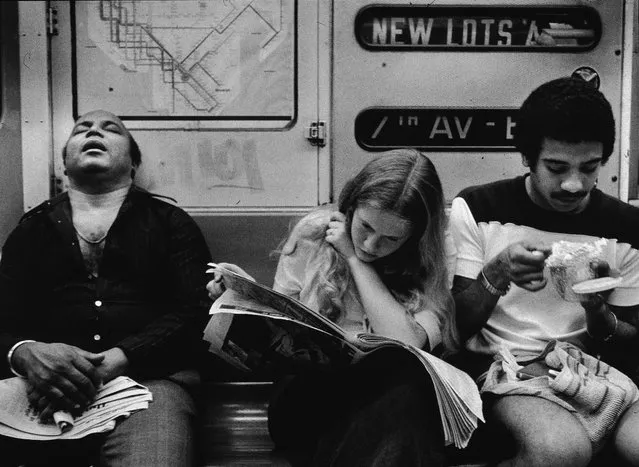
A view of three people sitting on the Number 2 line (7 Avenue Express) IRT subway, New York, in the 1970s. One man sleeps, a young woman reads a newspaper, and a young man eats. (Photo by Tony Vaccaro/Getty Images)
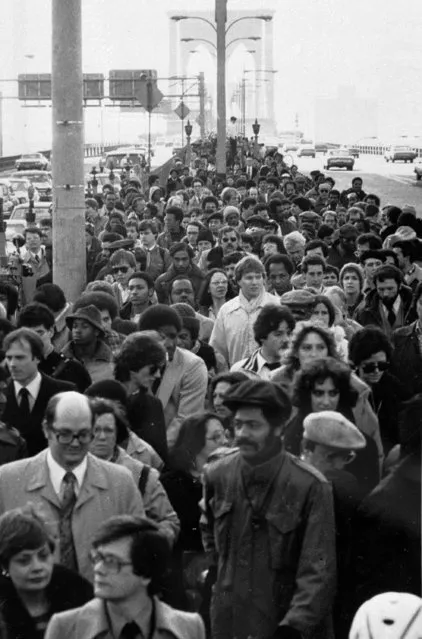
Thousands of New Yorkers cross the Brooklyn Bridge heading for work in Manhattan on April 2, 1980, the second day of the transit strike which halted city subway and bus service. (Photo by Carlos Rene Perez/AP Photo)
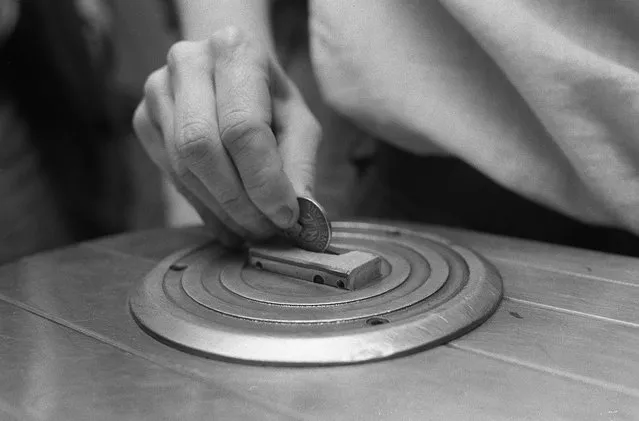
A New York subway rider inserts a token into a turnstile at the Rockefeller Center station, June 1980. (Photo by AP Photo)
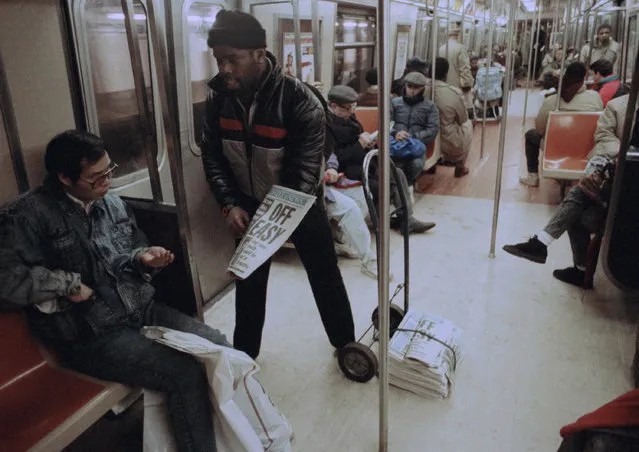
Barry Couliffe sells copies of the Daily News to an unidentified passenger on the subway in New York, Thursday, March 15, 1991. (Photo by Bebeto Matthews/AP Photo)
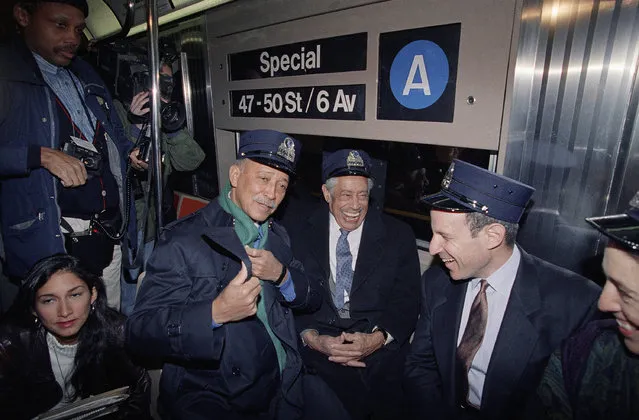
Jazz great Cab Calloway, center, jokes with New York City Mayor David Dinkins, left, and Grammy organizer Jonathan Tisch, while riding a specially designated subway train from Harlem to Radio City Music Hall as part of the Grammy Week festivities in New York, February 18, 1992. New York's subway system was immortalized in the Duke Ellington classic “Take the «A» Train”. (Photo by Alex Brandon/AP Photo)
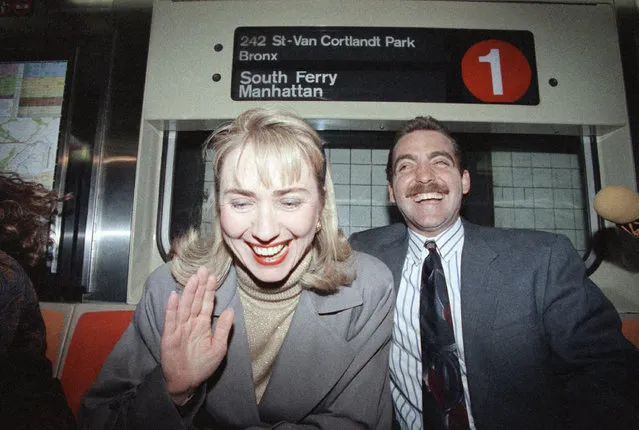
Hillary Rodham Clinton, wife of Democratic presidential hopeful Gov. Bill Clinton of Arkansas, shares a laugh with Scott Stillman of Queens, New York, March 30, 1992, as they ride the New York City subway. Clinton, campaigning for her husband, was en route to New York University where she delivered a speech to law students. (Photo by Alex Brandon/AP Photo)
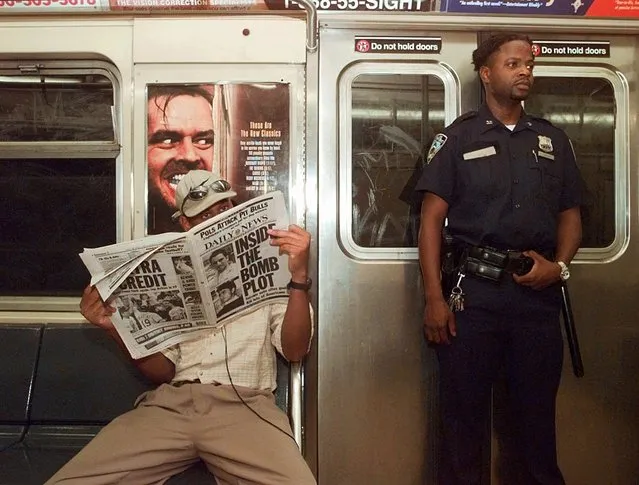
A subway rider reads a newspaper while on the “B” train in the Brooklyn borough of New York Saturday, August 2, 1997. Security has been increased on New York's subways following the arrest of two men suspected of a subway bombing plot. (Photo by Adam Nadel/AP Photo)
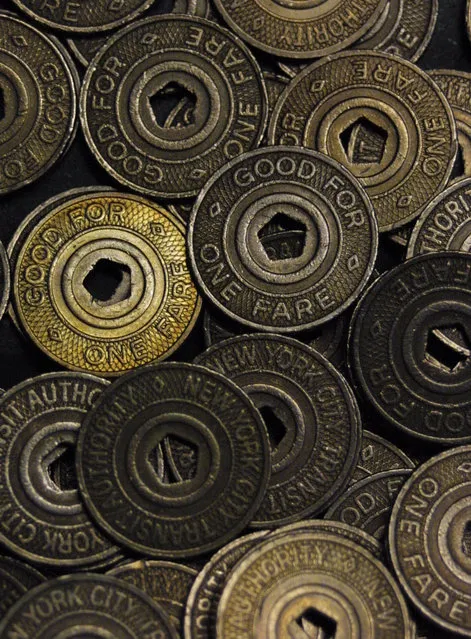
A pile of New York City subway tokens is shown, April 12, 2003 in New York. The city's subway token will no longer be accepted after May 4, its long career as the currency of city life ended by technology and fiscal problems. (Photo by Tina Fineberg/AP Photo)
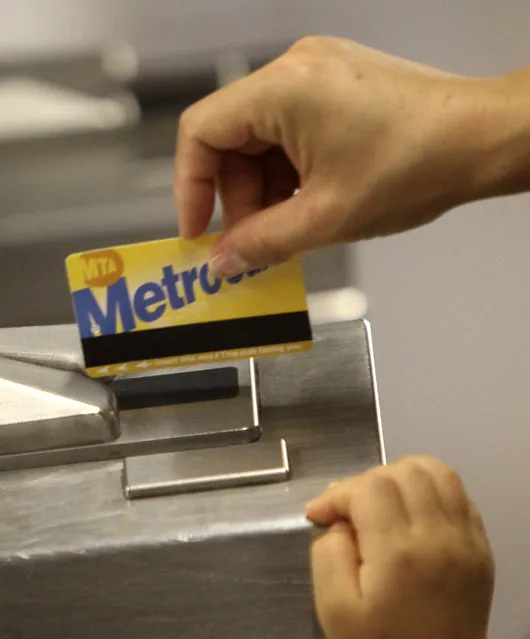
A subway rider swipes a MetroCard through the turnstiles in New York, July 28, 2010. New York's transit agency is proposing fare increases of more than 16 percent for monthly subway and bus passes and 9 percent hikes on suburban trains, another blow to commuters still getting used to service cuts last month that eliminated some subway and bus routes. (Photo by Seth Wenig/AP Photo)
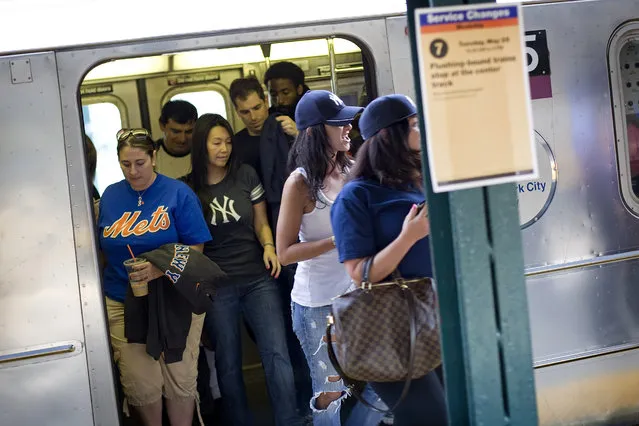
New York Mets and New York Yankees fans leave the No. 7 train as they attend the Subway Series interleague baseball game between the Mets and the Yankees at Citi Field in New York, May 21, 2010. (Photo by David Goldman/AP Photo)
26 Jan 2015 11:52:00,
post received
0 comments
